Biol 226 (A&P II) Lab Exercise 7 - Blood Pressure, Blood and Blood Typing, and Enzyme Activity
1/53
There's no tags or description
Looks like no tags are added yet.
Name | Mastery | Learn | Test | Matching | Spaced |
|---|
No study sessions yet.
54 Terms
As the amount of enzyme increased, so did the amount of product. All tests were incubated at 22°C
What influence did the quantity of enzyme have on the amount of filtrate produced?
Incubation at 4°C and 22°C resulted in less product compared to incubation at 37°C, so 37°C was the best temperature conditions. All had 1.0 mL of pectinase
What temperature condition was best for the activity of pectinase?
Not much. The results using enzyme that had been previously frozen resulted in slightly less product than using the same quantity of normal pectinase. Both were incubated at 22°C
Did freezing have any effect on the activity of pectinase? Explain.
Yes. There was less product compared to the control applesauce with 1.0 mL enzyme incubated at 22·°C
Did the lack of the acidic preservative have any effect on the activity of pectinase? Explain
Erythrocytes
This is a slide of normal human blood. What cells are these?
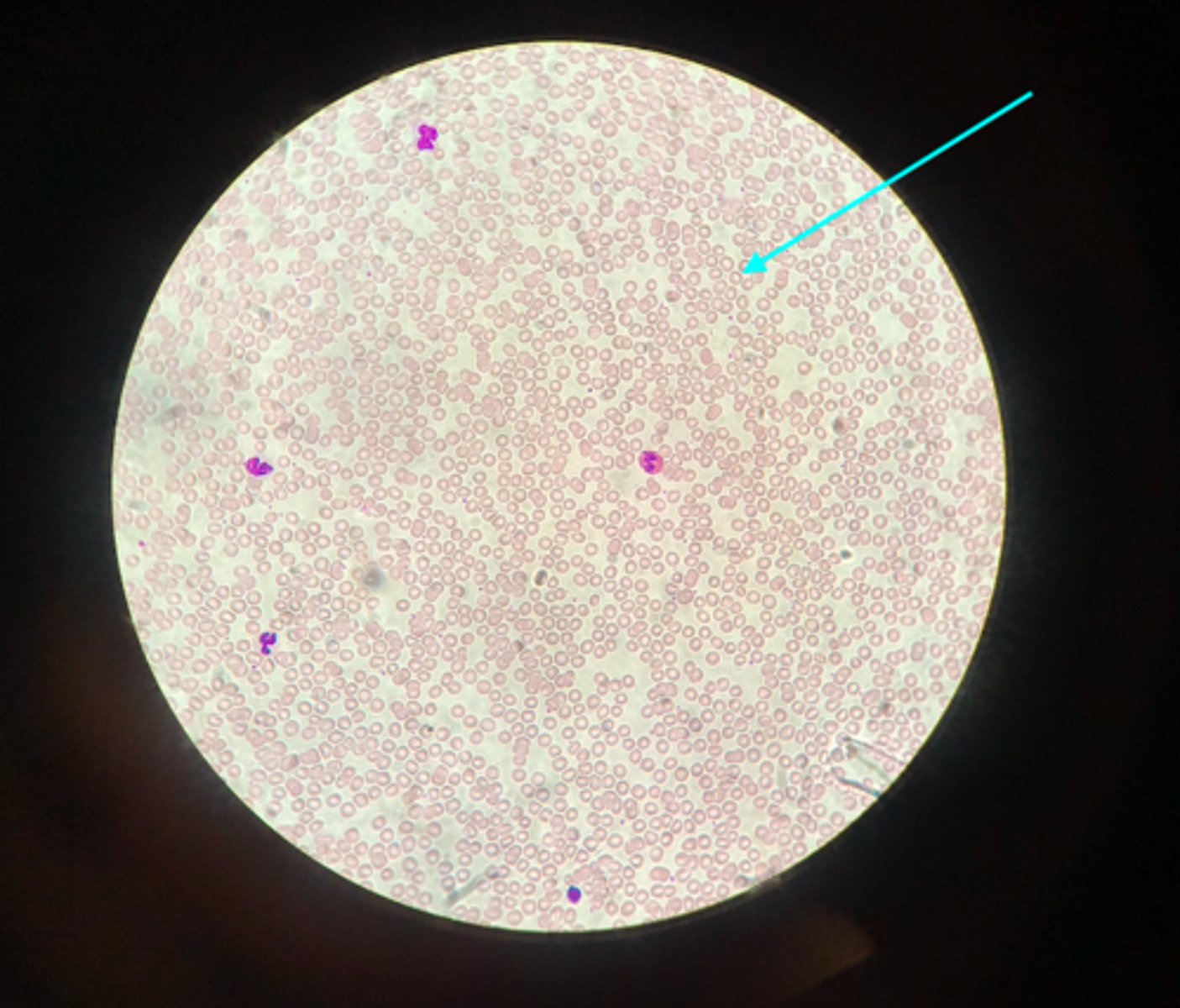
Leukocytes
This is a slide of normal human blood. What cells are these?
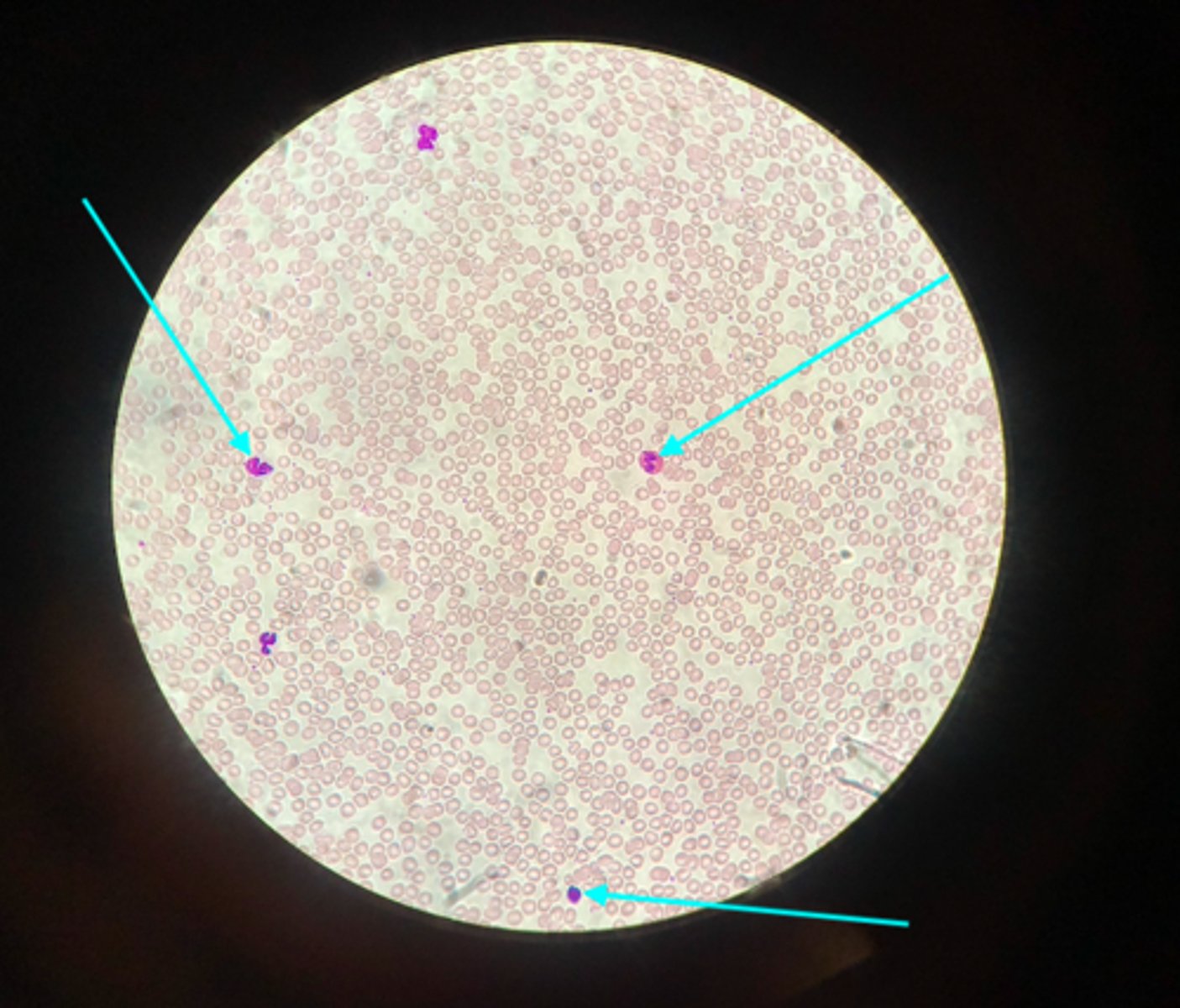
Granulocytes
There is a grainy substance within the cell cytoplasm
What type of leukocyte is this? How can you tell?

Agranulocytes
There is not a visible grainy substance within the cell cytoplasm
What type of leukocyte is this? How can you tell?
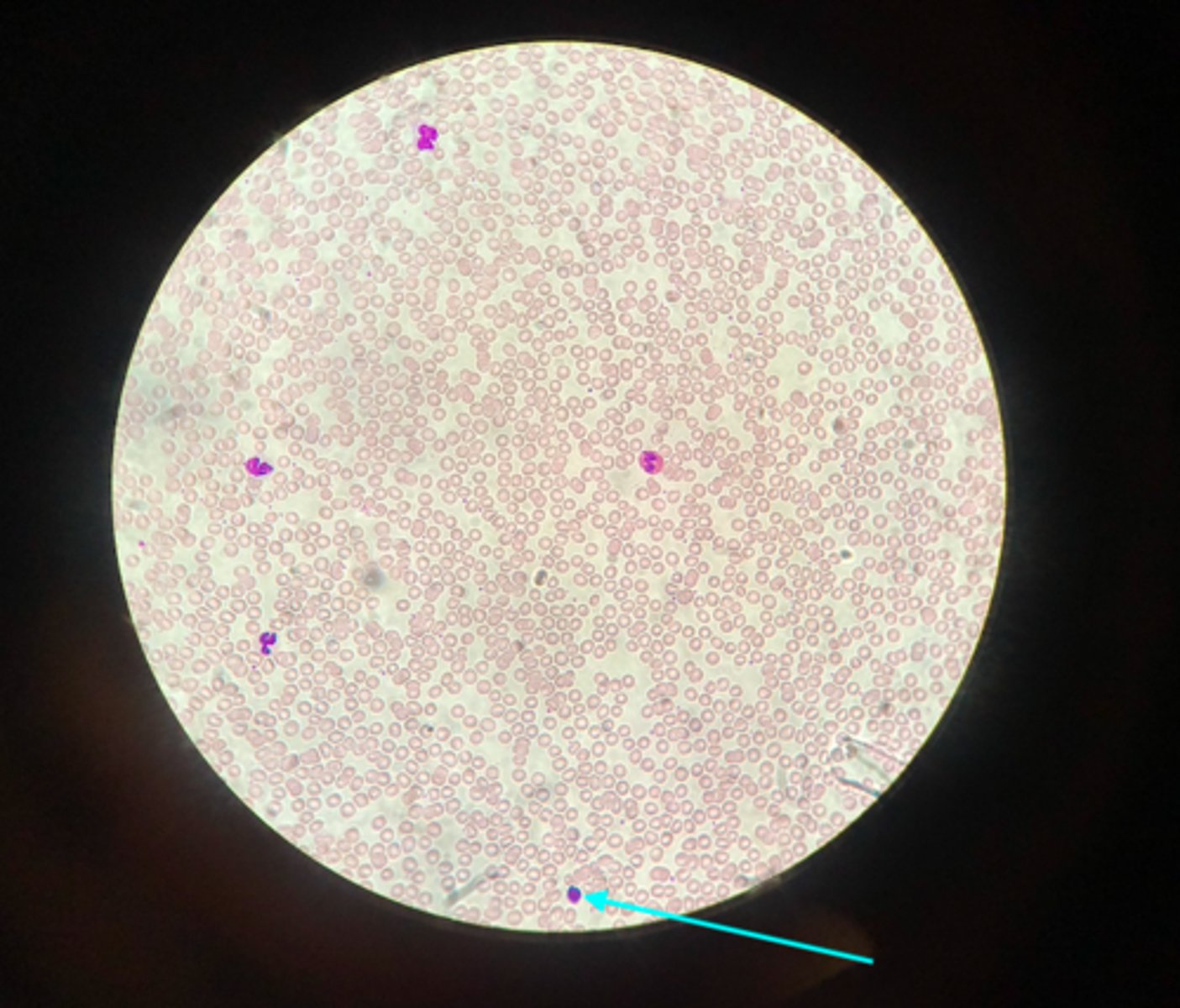
Granulocytes and agranulocytes
What are the two types of leukocytes discussed in lab?
Systolic blood pressure is the pressure generated as the heart contracts and ejects blood into the aorta. It is the maximum pressure achieved during ventricular contraction
What events are responsible for systolic blood pressure?
Diastolic blood pressure is the lowest pressure in blood vessels when the heart is not ejecting. It is the lowest pressure that remains in the arteries before the next ventricular contraction
What events are responsible for diastolic pressure?
1. Wrap cuff of sphygmomanometer around brachial region of the subject
2. Palpate the antecubital region for a pulse. Should be able to find a pulse in the brachial artery as it passes through this region
3. Place tips of stethoscope in ears and bell of the stethoscope over the region where you felt the pule (you will not be able to hear the pulse at this time)
4. Inflate the cuff to around 200 mmHg and slowly deflate the cuff.
5. Note the reading on the dial when you first hear a pulse = systolic blood pressure
6. Continue to slowly deflate the cuff until the sound disappears. The last pressure at which you can hear the pulse = diastolic blood pressure
Be able to measure arterial blood pressure in a resting subject. Process listed.
PP = SBP - DBP
What is the formula for calculating pulse pressure?
MAP = DBP + [1/3 PP]
What is the formula for calculating mean arterial pressure?
DBP
mm Hg
What is the abbreviation and unit for diastolic blood pressure?
MAP
mm Hg
What is the abbreviation and unit for mean arterial pressure?
PP
mm Hg
What is the abbreviation and unit for pulse pressure?
SBP
mm Hg
What is the abbreviation and unit for systolic blood pressure?
The interaction between an antigen and the antibody for that same antigen
What does the clumping of blood in the blood typing demonstration represent?
Anti-B
If the A antigen is present in blood, what naturally occurring antibody is present?
Anti-A
If the B antigen is present in blood, what naturally occurring antibody is present?
None
If A, B, and D antigens are present in blood, what naturally occurring antibodies are present?
Anti-A and Anti-B
If only the D antigen (Rh) is present in the blood, what naturally occurring antibodies are present?
A antigen and anti-B antibodies
In A- blood, what antigens and naturally occurring antibodies are present?
A antigen, D antigen, and anti-B antibodies
In A+ blood, what antigens and naturally occurring antibodies are present?
B antigen and Anti-A antibody
In B- blood, what antigens and naturally occurring antibodies are present?
B antigen, D antigen, and anti-A antibody
In B+ blood, what antigens and naturally occurring antibodies are present?
Antigen A, Antigen B, Antigen D, and no antibodies
In AB+ blood, what antigens and naturally occurring antibodies are present?
Antigen A and antigen B, no antibodies
In AB- blood, what antigens and naturally occurring antibodies are present?
Antigen D, anti-A, and anti-B antibodies
In O+ blood, what antigens and naturally occurring antibodies are present?
There are no antigens present, and anti-A, anti-B antibodies present.
In O- blood, what antigens and naturally occurring antibodies are present?
Antigen D
What antigen corresponds with Rh?
Be able to identify all donor and recipient possibilities for any ABO/Rh blood type
Be able to solve problems concerning the genetics of blood types, including the identification of phenotypes and genotypes
Sickle cell anemia
What condition does a person with this blood sample have?
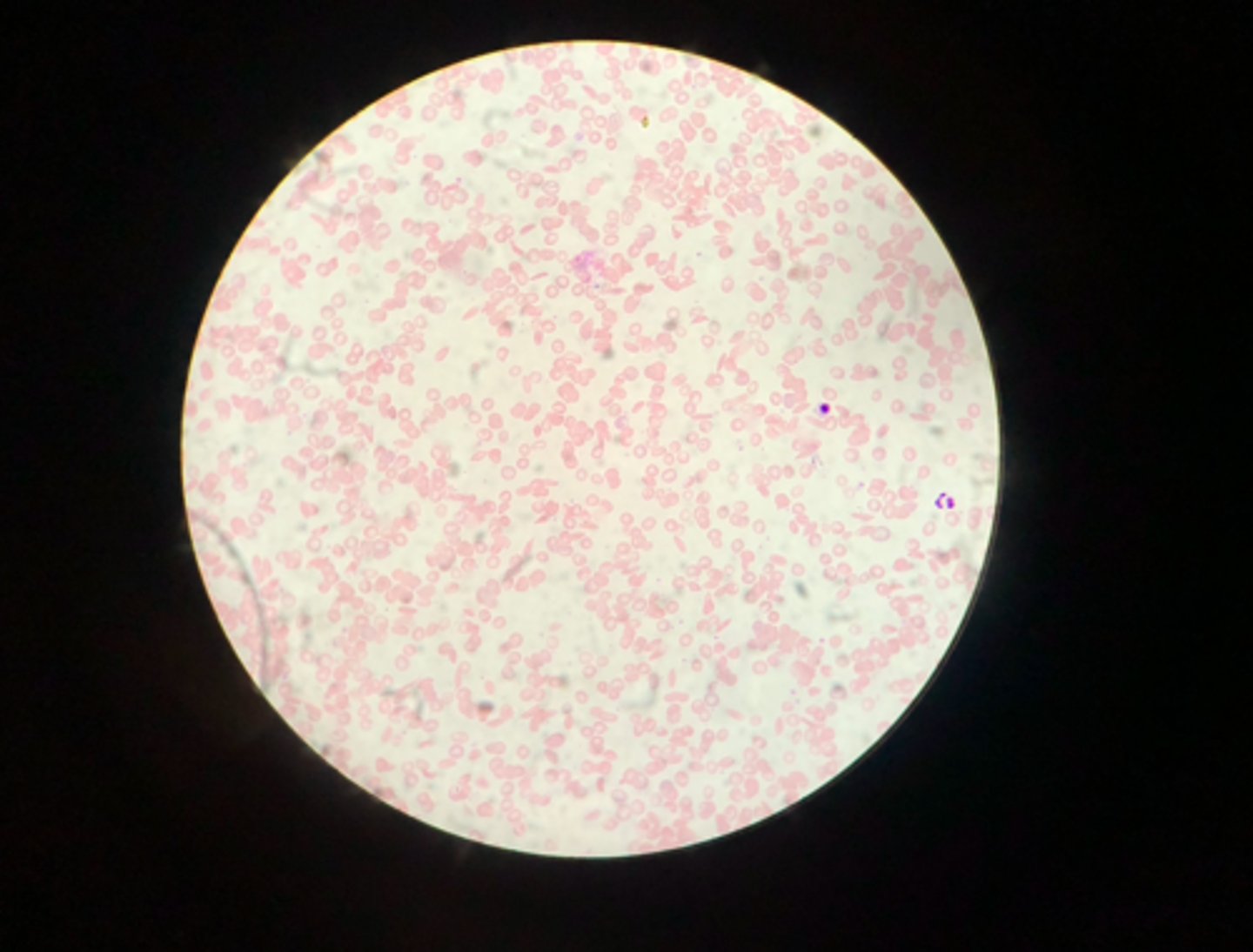
Leukemia
The abundance of leukocytes (dark purple) in the sample is alarming
What condition does a person with this blood sample have? How can you tell?
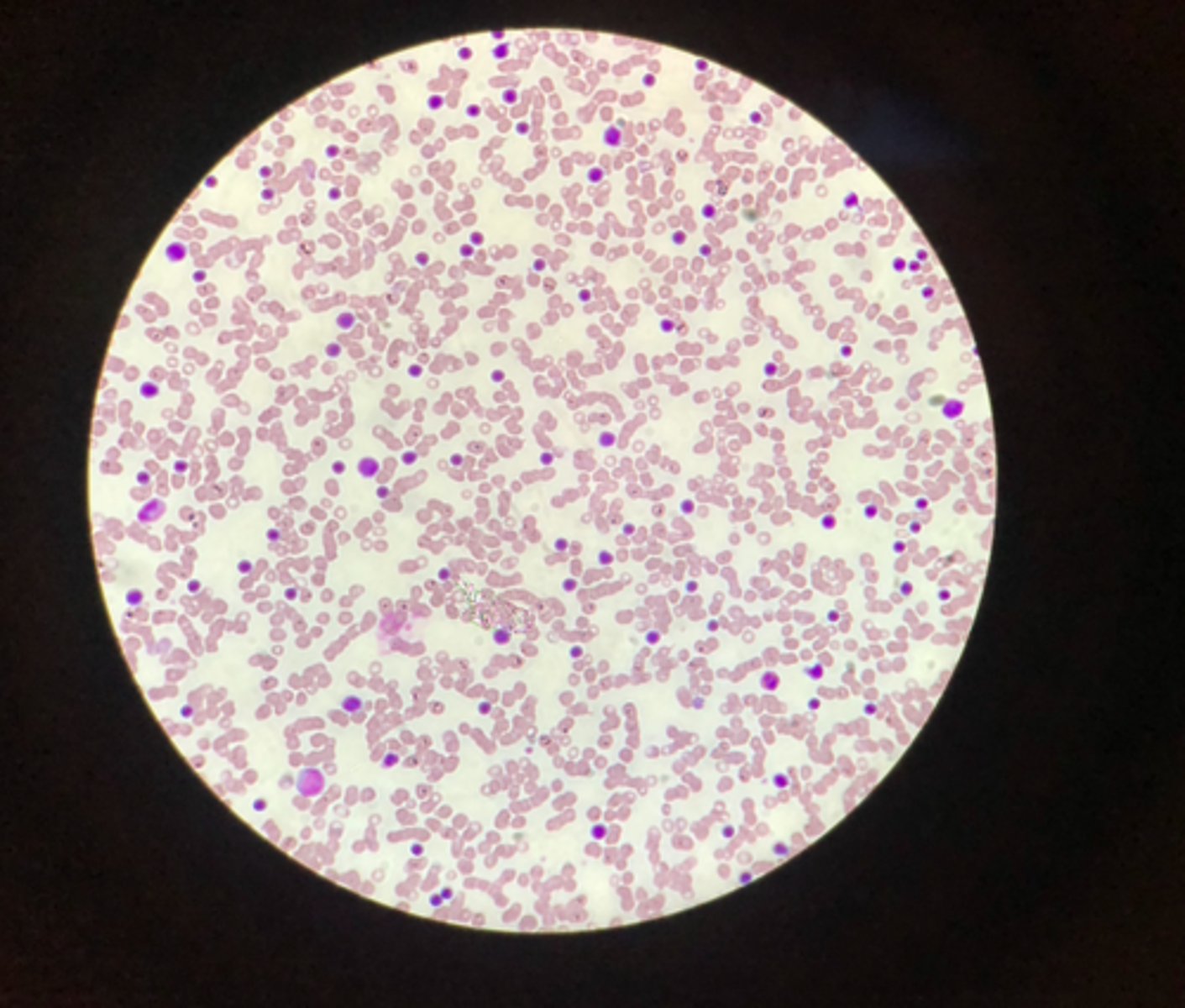
R
What genotypic symbol represents the presence of the Rh factor?
r
What genotypic symbol represents the absence of the Rh factor?
I^A
What genotypic symbol represents the presence of alleles for antigen A?
I^B
What genotypic symbol represents the presence of alleles for antigen B?
i
What genotypic symbol represents the absence of alleles for antigens A and B?
Co-dominant
This term describes the I^A and I^B alleles and how they are both dominant over the i allele
Compare the results of the enzyme to a negative and positive control under the same conditions. If given starting and ending samples after enzyme activity, look at what the enzyme is supposed to do under normal conditions. This would be the positive control. The sample with the most filtrate demonstrates the highest activity of the enzyme
Be able to interpret sample results demonstrating the activity of a digestive enzyme. How would you do this?
At the ideal temperature, the most filtrate will be produced or the samples will be converted to desired product due to proper enzyme activity. Need to compare to controls as well as contents of starting and ending samples
Be able to interpret sample results to determine the ideal temperature for enzyme activity. How would you do this?
AT the ideal pH, the most filtrate will be produced or the samples will be converted to the desired product due to proper enzyme activity. You need to compare to controls as well as the contents of starting and ending samples.
Be able to interpret sample results to determine the ideal pH condition for enzyme activity. How would you do this?
Start at the unfavorable temperature and then return the mixtures to temperature conditions that are know to be favorable (22°C or 37°C). If the sample is now digested by the enzymes, then the enzyme was only inhibited. If the sample is not digested, then the enzyme has been permanently denatured
Be able to interpret sample results or design an experiment to determine whether temperature (environmental) conditions were merely inhibiting the activity of an enzyme or actually destroying the enzyme. How would one do this?
Set up a series of experiments at pH = 1, pH = 2, and so on. Run the experiments at the ideal temperature and make sure all experiments are identical with the exception of the pH. Determine which situation yields the most product. That pH is then "ideal". Using an acid or base, adjust the pH of any experiments that yielded no product to the ideal pH. If a product now results, the enzyme was inhibited. If no product results, the enzyme has been permanently denatured
Be able to interpret sample results or design experiment to determine whether pH (environmental) conditions were merely inhibiting the activity of an enzyme or actually destroying the enzyme. How would one do this?
The negative control confirms there is no contamination in the reagent. In most experiments, this should yield no product (negative result). The positive control confirms that the reagents are working. Results from the two should be remarkably different. This allows us to compare the results of the reaction to the controls to determine a true effect.
Why is it important to have two controls (positive and negative) in an experiment?
View activity 3 application questions for blood typing information.
Dominant traits (A,B, Rh+) are always expressed if the gene is present. Recessive traits (O, Rh-) are expressed only in the absence of any dominant traits. Since A and B are both dominant, both will be expressed if present (AB blood). This is called co-dominance
Explain the difference between dominant, recessive, and co-dominant inheritance with respect to ABO and Rh blood types
Without additional information, we assume that the woman and her husband both possess recessive alleles (i,r). Therefore, the woman's genotype could be I^AiRr and her husbands genotype could be I^Birr, so a child with O- blood (iirr) is possible
A woman with type A+ blood gives birth to a child with type O- blood. Her husband, who has type B- blood, states the the child could not be his. Could he be the father of this child? Defend your answer
Without additional information, assume both have recessive alleles, so her genotype may be I^BiRr and her husbands could be I^Airr. Possible phenotypes could be A+, A-, B+, B-, AB+, AB-, O+, and O-
A woman has type B+ blood, and her husband has type A- blood. Based on this information alone, list all possible blood types that their children could have.
Yes. The results using enzyme that had been previously boiled were less than the control (1.0 mL enzyme at 22°C) and were relatively similar to the negative control
Did boiling have any effect on the activity of pectinase? Explain.
View part D. Application for enzyme activity under various conditions